Rapid Microbiology Testing Market Size
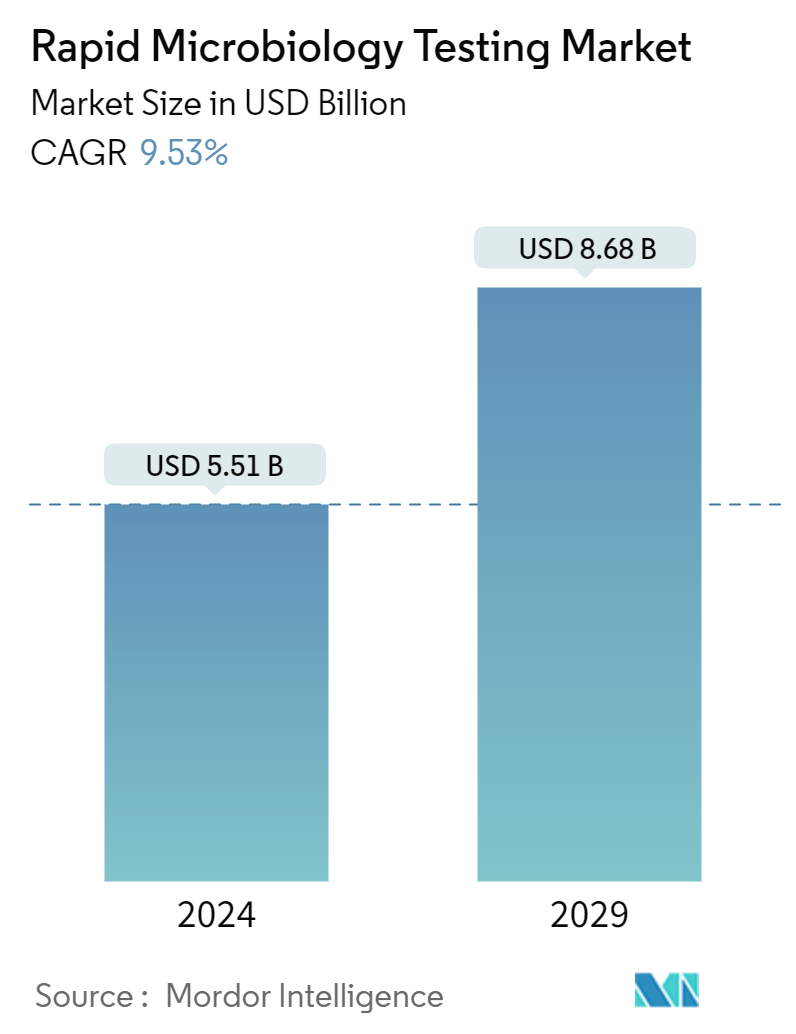
| Study Period | 2019 - 2029 |
| Market Size (2024) | USD 5.51 Billion |
| Market Size (2029) | USD 8.68 Billion |
| CAGR (2024 - 2029) | 9.53 % |
| Fastest Growing Market | Asia Pacific |
| Largest Market | North America |
Major Players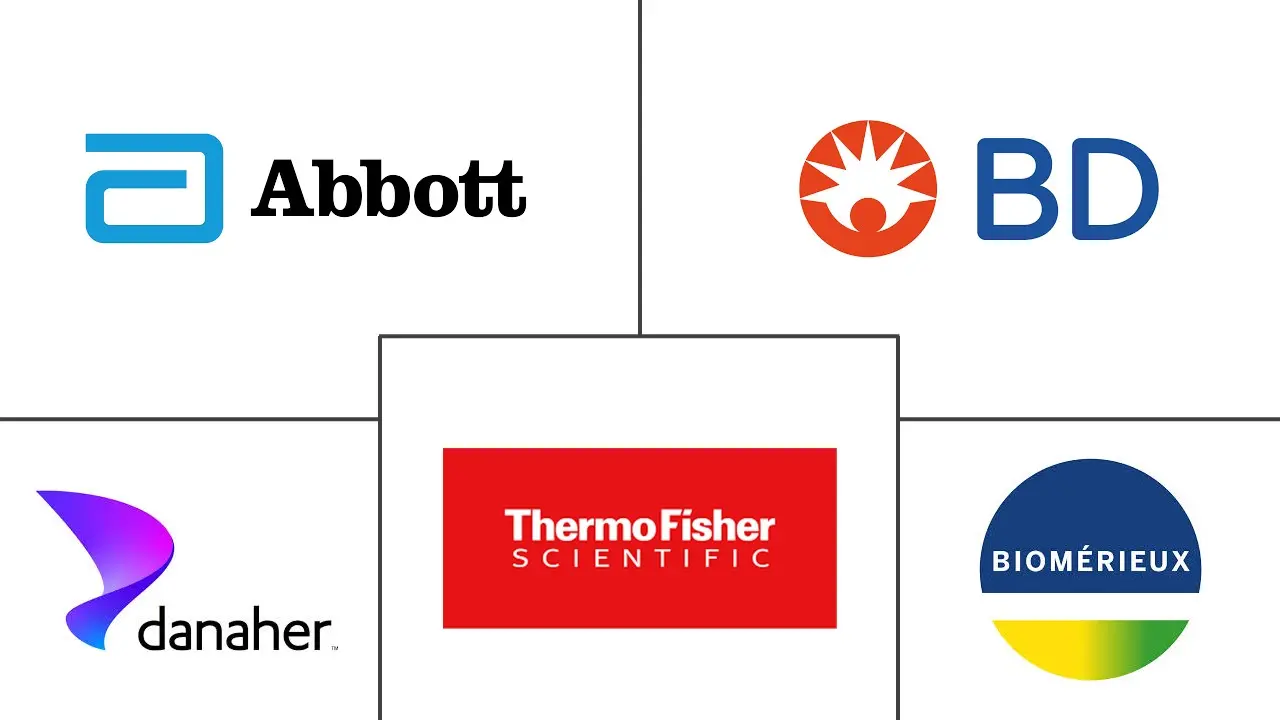
*Disclaimer: Major Players sorted in no particular order |
Rapid Microbiology Testing Market Analysis
The Rapid Microbiology Testing Market size is estimated at USD 5.51 billion in 2024, and is expected to reach USD 8.68 billion by 2029, growing at a CAGR of 9.53% during the forecast period (2024-2029).
Rapid microbiology testing is the near-real-time or real-time analysis of microbial presence in a sample without incubation, intervention, or laboratory services. With rapid urbanization, water pollution has become increasingly severe, causing several diseases, such as dysentery and enteritis, and is particularly prominent in developing nations. Hence, routine surveillance of pathogens in water is essential for public health, especially the water utilized in the food and beverage and pharmaceutical sectors. For instance, the CDC’s March 2024 estimates showcased that Salmonella bacteria cause about 1.35 million infections and 26,500 hospitalizations annually in the United States. However, the current detection methods are slow and lack accuracy, which makes it difficult to prevent and control water-borne diseases. It, thus, necessitates the requirement for rapid microbiology testing.
Additionally, the rising consumption of packaged food globally is boosting the growth of the food and beverage industry. This, in turn, is prompting the requirement for stringent inspection for any food-borne diseases. For instance, in February 2024, Modesto-based Rizo Lopez Foods Inc. recalled all packaged goods produced in the month due to potential contamination with listeriosis causing Listeria monocytogenes. Again, data published in May 2023 by Food Standards Australia New Zealand (FSANZ) showcased that a significant portion of packaged food recalls in Australia and New Zealand were related to microbial contamination and foreign matter. Such incidents necessitate the application of rapid methods of microbial analysis to deliver the critical information needed to maintain control of the production process across different industry verticals.
Furthermore, at present, the detection of pathogenic bacteria in food and water is mainly based on selective culture and standard biochemical methods. With a persistent rise in infectious diseases worldwide, the demand for rapid and precise testing kits is rising, promoting the market's growth and leading to the development of advanced testing kits. For instance, in February 2024, Nemis Technologies AG unveiled the N-Light Salmonella Risk Indicator Test, an advanced real-world environmental monitoring kit for food processing facilities. Such developments of advanced kits aid in the broader usage of rapid test kits in food manufacturing facilities.
Moreover, the rising research of rapid microbial testing in containing and managing large-scale infectious diseases is also anticipated to drive the market's growth. For instance, in September 2023, scientists at the University of Surrey developed Electro-chemical LAMP (eLAMP), an affordable new molecular test for bacteria and viruses, including SARS-CoV-2. The development of the product was aimed at easily containing any future pandemic-like situations, as encountered during the COVID-19 pandemic.
Thus, the rising availability and the growing demand for rapid microbiology testing from the food and beverage industry are expected to drive the market’s growth. However, industrial applications of rapid microbiology testing require a substantial upfront investment since most instruments and testing kits utilized for rapid microbiology testing have relatively higher prices. Such factors act as a restraint for the market.
Rapid Microbiology Testing Market Trends
Instruments Segment is Expected to Witness Significant Growth During the Forecast Period
- A wide range of instruments can be utilized for rapid microbiology testing. The rising demand for these instruments across different end-user segments is anticipated to drive the segment’s growth in the coming years. For instance, in February 2024, the Global Challenges Research Fund through Innovate UK, in collaboration with the Council for Scientific and Industrial Research-Ghana, trained farmers and other industry players in the aquaculture space on rapid bacteria testing kits to improve water quality. The training was aimed at achieving Ghana’s new Aquaculture Development Plan, which aims to increase the country’s fish farming output from ~89,500 metric tons in 2021 to ~212,000 metric tons by the end of 2027. Such vivid applications and new product launches are expected to drive the segment’s growth.
- Additionally, the rising applications of rapid microbiology testing instruments have led to the launch of advanced devices and kits from several players, targeting different industry verticals. For instance, in February 2024, Byonoy GmbH introduced Luminescence 96 Automate with accessible integration features on deck, allowing for seamless automated luminescence measurements. Similarly, in July 2023, PathogenDx launched Sero, a new rapid, single test that detects salmonella and 13 serotypes in a single shift to easily detect and control salmonella outbreaks in the poultry sector. Again, in June 2023, India’s Bengaluru-based startup GenWorks launched in vitro diagnostics (IVD) tests, including rapid card test kits for dengue and malaria. iScreen Dengue NS1 kit offers an immunochromatographic one-step rapid card solution for qualitative early acute dengue detection with NS1 antigen and differential detection of dengue IgG and IgM antibodies in human serum. Considering the rising cases of dengue globally, the demand for such rapid assay kits is expected to witness brisk growth. Such product launches globally aid in the adoption of rapid microbiology testing instruments and promote the growth of the segment.
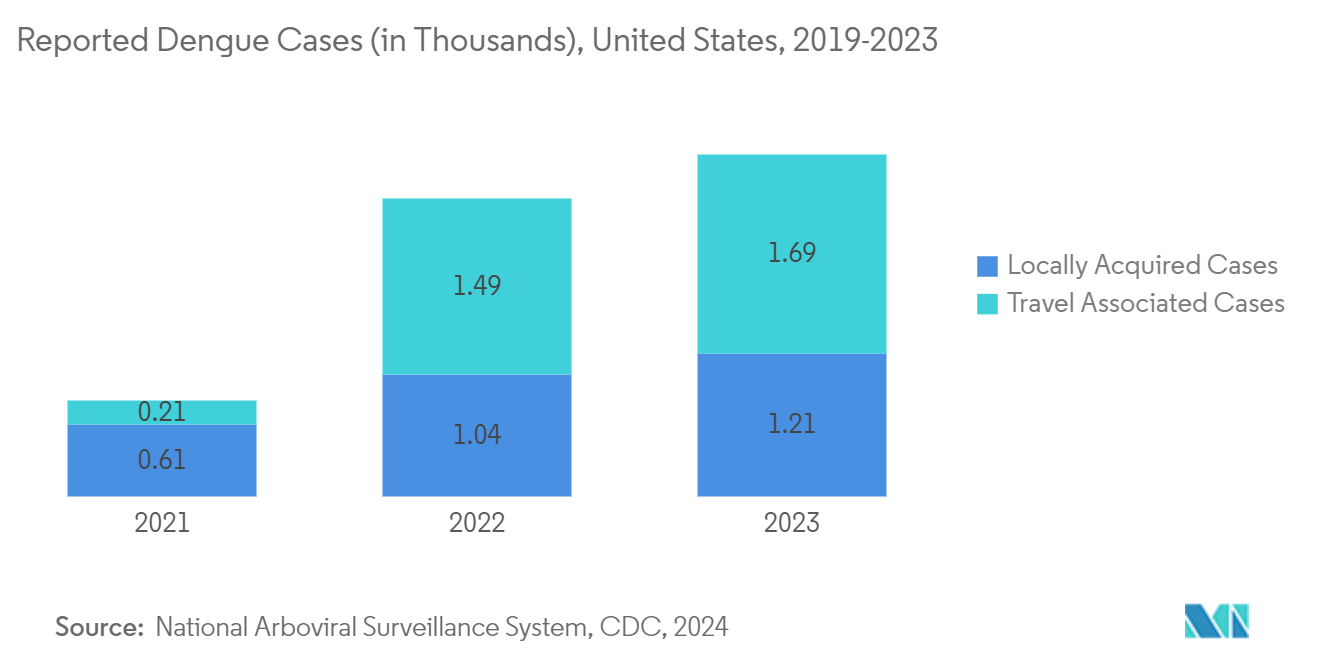
North America is Expected to Dominate the Rapid Microbiology Testing Market
- North America is expected to dominate the market due to higher acceptance of advanced technologies, well-developed research facilities, highly regulated industrial and healthcare landscape, developed healthcare infrastructure, established players in the region, and new product launches. For instance, in January 2024, Thermo Fisher Scientific launched the Invitrogen TaqMan Cells-to-CT Express Kit. The new kit is expected to offer simplified, scalable workflows for gene expression analysis through improved chemistry and facilitate the preparation of cell lysates for reverse transcription (RT) real-time PCR (qPCR) in just 5 minutes. Such advanced testing kits promote the adoption of rapid microbiology testing and are expected to drive market growth in the region.
- Additionally, the region has a widespread prevalence of acquired immunodeficiency syndrome (AIDS) caused by the human immunodeficiency virus (HIV). As per December 2023 data from HIV.gov, ~1.2 million people in the United States had HIV, while an estimated 13% of them were not aware of the same and required testing. The cumulative number has increased slightly owing to prolonged life expectancy because of effective treatment and ongoing new HIV infections. Early detection of AIDS can ensure higher life expectancy since the treatment can be started early. Owing to rising awareness of the same, there is a growing demand for rapid HIV testing kits. This, in turn, is expected to drive the demand in the rapid microbiology testing market.
- Furthermore, the market is driven by increased government initiatives and increasing adoption of rapid methods by the food and beverage industries. For instance, in December 2023, the FDA approved the SensiTox B. anthracis Toxin Test and SensiTox C. difficile Toxin Test of First Light Diagnostics. The development was supported in whole or in part with federal funds from the Administration for Strategic Preparedness and Response (ASPR), the Biomedical Advanced Research and Development Authority (BARDA), and the US Department of Health and Human Services (HHS). Similarly, in April 2023, the National Institute of Standards and Technology (NIST) hosted a workshop on collaborative efforts to enable the adoption of rapid microbial testing for advanced therapy products. The workshop aimed to promote rapid testing methodologies, considering emerging advanced therapy products require more rapid results. Such funding and initiatives promote the adoption of rapid microbiology testing products, thus contributing to market growth.
- Similar to the United States, Canada is also undertaking heavy research to ensure food safety. For instance, in March 2024, Hygiena, a leading food safety solutions provider, received official approval for the publication of its innovative method for detecting Escherichia coli O157:H7/NM in Raw Meat Products from Health Canada. Again, in April 2023, researchers at McMaster University in Ontario, Canada, developed the world's first rapid test for detecting salmonella bacteria in less than an hour. Presently available tests for salmonella are culture-based and can take up to a day to provide results. If approved, the rapid test kit can enable faster testing of food products and ensure the safety of consumers, according to the researchers. Such research and strategic initiatives by key players are expected to contribute to market growth.
- Therefore, owing to the presence of several prominent players, the launch of advanced products, and government initiatives and support, the market is expected to grow in North America.
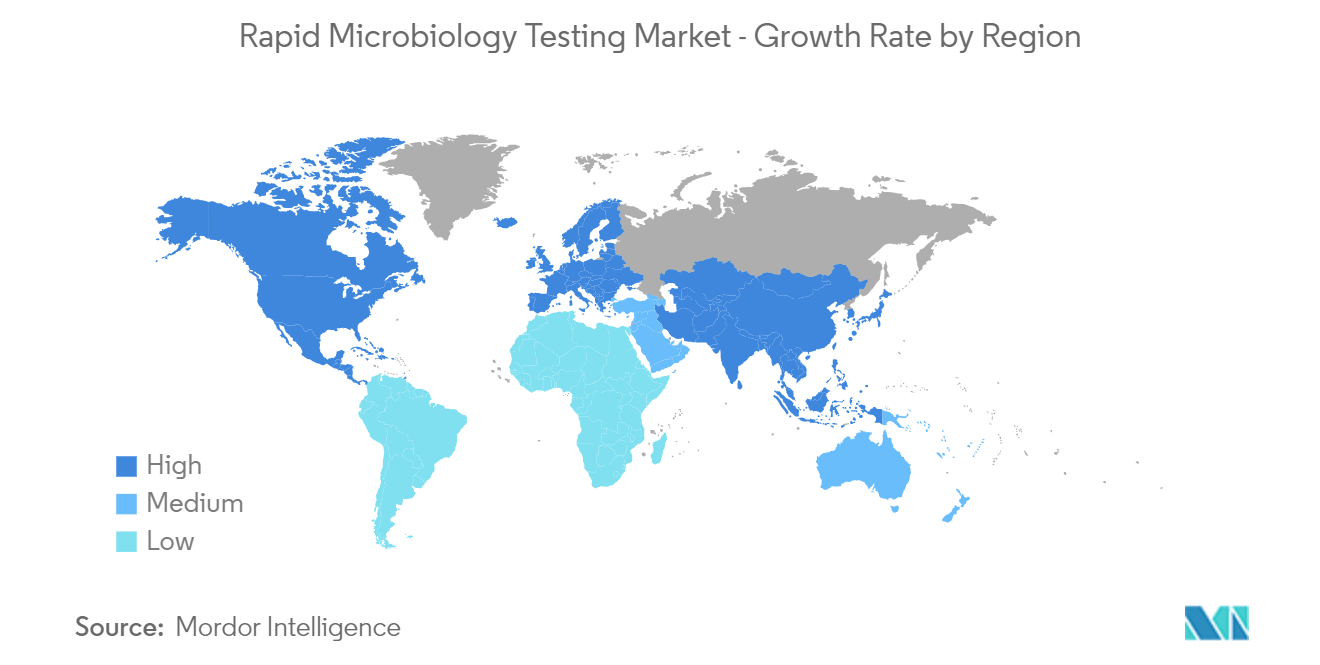
Rapid Microbiology Testing Industry Overview
The rapid microbiology testing market is moderately consolidated due to a few companies commanding a significant market share. The competitive landscape includes an analysis of a few international as well as local companies that hold substantial market share and are well known, including Abbott Laboratories, Becton, Dickinson & Company, bioMerieux SA, Bruker Corporation, Charles River, Danaher Corporation, Merck KGaA, Sartorius Group, Shimadzu Corporation, and Thermo Fisher Scientific.
Rapid Microbiology Testing Market Leaders
-
Abbott Laboratories
-
Becton, Dickinson & Company
-
bioMérieux SA
-
Danaher Corporation
-
Thermo Fisher Scientific
*Disclaimer: Major Players sorted in no particular order
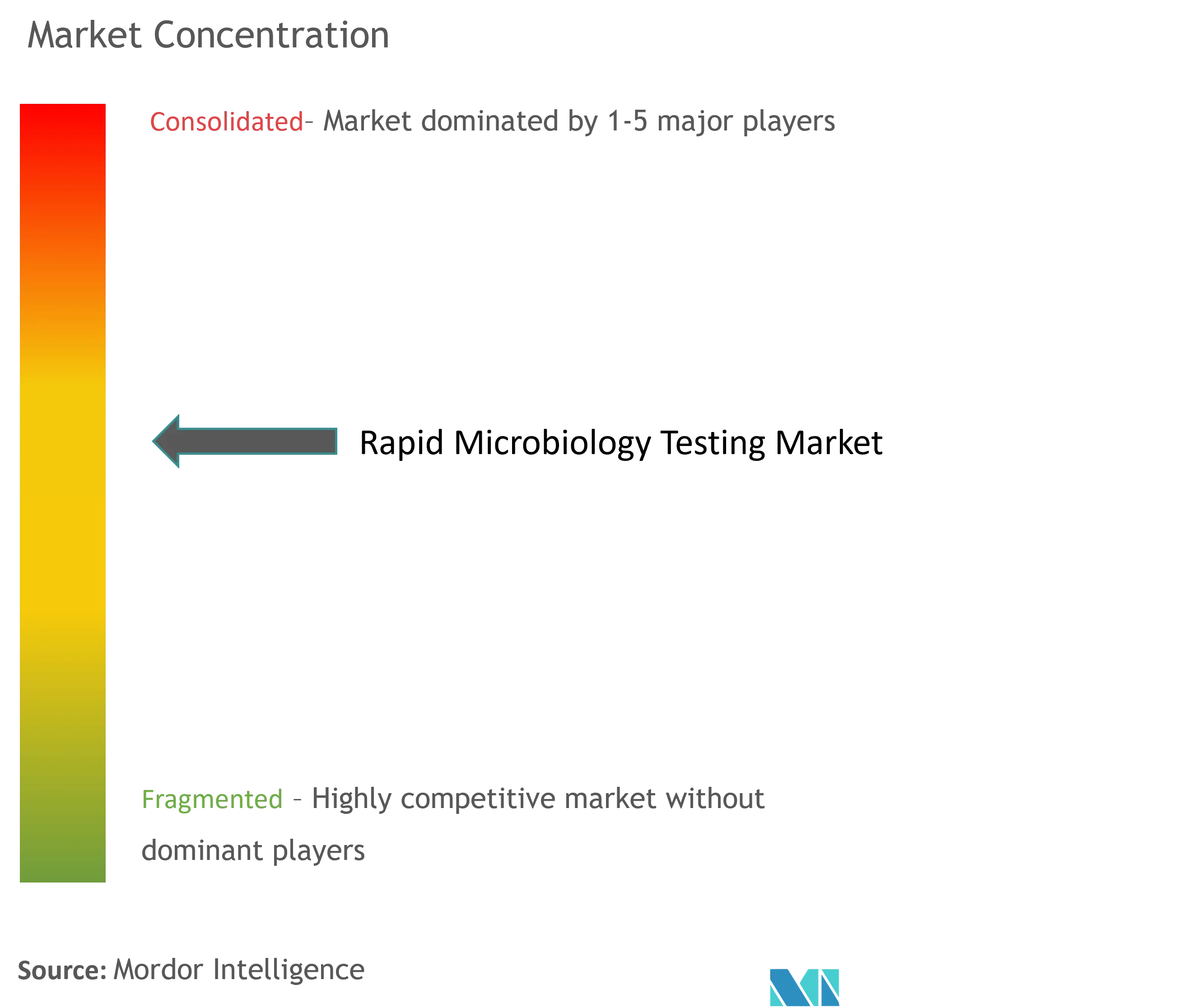
Rapid Microbiology Testing Market News
- March 2024: bioMerieux SA formed a strategic research collaboration with the US FDA, OARSA, CFSAN, and Regulatory Science (ORS) to research and develop novel technologies to enhance the detection of Cyclospora cayetanensis, improve the isolation of Shiga-toxin-producing E. coli (STECs), and simplify microbial characterization methods for food-borne pathogens, including salmonella and listeria monocytogenes.
- February 2024: Charles River added a new animal-free testing solution to its endotoxin testing (BET) portfolio to deliver rapid, quantitative results, eliminating the need to prepare multiple reagents and reducing the opportunity for technician error.
Rapid Microbiology Testing Market Report - Table of Contents
1. INTRODUCTION
- 1.1 Study Assumption and Market Definition
- 1.2 Scope of the Study
2. RESEARCH METHODOLOGY
3. EXECUTIVE SUMMARY
4. MARKET DYNAMICS
- 4.1 Market Overview
-
4.2 Market Drivers
- 4.2.1 Rising Number of Infectious Diseases
- 4.2.2 Increasing Adoption by Food and Beverage Industry
- 4.2.3 Growing Government Initiatives
-
4.3 Market Restraints
- 4.3.1 High Initial Investment in Instruments
-
4.4 Porter's Five Forces Analysis
- 4.4.1 Threat of New Entrants
- 4.4.2 Bargaining Power of Buyers/Consumers
- 4.4.3 Bargaining Power of Suppliers
- 4.4.4 Threat of Substitute Products
- 4.4.5 Intensity of Competitive Rivalry
5. MARKET SEGMENTATION (Market Size by Value - USD)
-
5.1 By Product Type
- 5.1.1 Consumables
- 5.1.2 Instruments
- 5.1.2.1 Automated Identification and Testing Systems
- 5.1.2.2 Bioluminescence and Fluorescence-based Detection Systems
- 5.1.2.3 Mass Spectrometers
- 5.1.2.4 Other Product Types
- 5.1.3 Reagents and Kits
-
5.2 By Method
- 5.2.1 Cellular Component-based Testing
- 5.2.2 Nucleic Acid-based Testing
- 5.2.3 Other Methods
-
5.3 By End User
- 5.3.1 Clinical Laboratories
- 5.3.2 Food and Beverage Industry
- 5.3.3 Healthcare Facilities
- 5.3.4 Life Science Research and Development Facilities
- 5.3.5 Other End Users
-
5.4 By Geography
- 5.4.1 North America
- 5.4.1.1 United States
- 5.4.1.2 Canada
- 5.4.1.3 Mexico
- 5.4.2 Europe
- 5.4.2.1 Germany
- 5.4.2.2 United Kingdom
- 5.4.2.3 France
- 5.4.2.4 Italy
- 5.4.2.5 Spain
- 5.4.2.6 Rest of Europe
- 5.4.3 Asia-Pacific
- 5.4.3.1 China
- 5.4.3.2 Japan
- 5.4.3.3 India
- 5.4.3.4 Australia
- 5.4.3.5 South Korea
- 5.4.3.6 Rest of Asia-Pacific
- 5.4.4 Middle East and Africa
- 5.4.4.1 GCC
- 5.4.4.2 South Africa
- 5.4.4.3 Rest of Middle East and Africa
- 5.4.5 South America
- 5.4.5.1 Brazil
- 5.4.5.2 Argentina
- 5.4.5.3 Rest of South America
6. COMPETITIVE LANDSCAPE
-
6.1 Company Profiles
- 6.1.1 Abbott Laboratories
- 6.1.2 Becton, Dickinson & Company
- 6.1.3 bioMerieux SA
- 6.1.4 Bruker Corporation
- 6.1.5 Charles River
- 6.1.6 Danaher Corporation
- 6.1.7 Merck KGaA
- 6.1.8 Sartorius Group
- 6.1.9 Shimadzu Corporation
- 6.1.10 Thermo Fisher Scientific
- *List Not Exhaustive
7. MARKET OPPORTUNITIES AND FUTURE TRENDS
** Subject To AvailablityRapid Microbiology Testing Industry Segmentation
Rapid microbiology testing refers to the near-real-time analysis of a sample to determine the presence of a microbe of interest. Different companies have launched advanced kits to obtain accurate results through rapid microbiology testing.
The rapid microbiology testing market is segmented into product type, method, end-user, and geography. The market is segmented by product type into consumables, instruments, and reagents and kits. The instruments segment is further segmented into automated identification and testing systems, bioluminescence and fluorescence-based detection systems, mass spectrometers, and other instruments. The market is segmented by method into cellular component-based testing, nucleic acid-based testing, and other methods. Based on end user, the market is segmented into clinical laboratories, food and beverage industry, healthcare facilities, life science research and development facilities, and other end users. By geography, the market is segmented into North America, Europe, Asia-Pacific, Middle East and Africa, and South America. The report also offers the market size and forecasts for 17 countries across the region. For each segment, the market sizing and forecasts were made on the basis of value (USD).
| By Product Type | Consumables | |
| Instruments | Automated Identification and Testing Systems | |
| Bioluminescence and Fluorescence-based Detection Systems | ||
| Mass Spectrometers | ||
| Other Product Types | ||
| Reagents and Kits | ||
| By Method | Cellular Component-based Testing | |
| Nucleic Acid-based Testing | ||
| Other Methods | ||
| By End User | Clinical Laboratories | |
| Food and Beverage Industry | ||
| Healthcare Facilities | ||
| Life Science Research and Development Facilities | ||
| Other End Users | ||
| By Geography | North America | United States |
| Canada | ||
| Mexico | ||
| By Geography | Europe | Germany |
| United Kingdom | ||
| France | ||
| Italy | ||
| Spain | ||
| Rest of Europe | ||
| By Geography | Asia-Pacific | China |
| Japan | ||
| India | ||
| Australia | ||
| South Korea | ||
| Rest of Asia-Pacific | ||
| By Geography | Middle East and Africa | GCC |
| South Africa | ||
| Rest of Middle East and Africa | ||
| By Geography | South America | Brazil |
| Argentina | ||
| Rest of South America |
Rapid Microbiology Testing Market Research FAQs
How big is the Rapid Microbiology Testing Market?
The Rapid Microbiology Testing Market size is expected to reach USD 5.51 billion in 2024 and grow at a CAGR of 9.53% to reach USD 8.68 billion by 2029.
What is the current Rapid Microbiology Testing Market size?
In 2024, the Rapid Microbiology Testing Market size is expected to reach USD 5.51 billion.
Who are the key players in Rapid Microbiology Testing Market?
Abbott Laboratories, Becton, Dickinson & Company, bioMérieux SA, Danaher Corporation and Thermo Fisher Scientific are the major companies operating in the Rapid Microbiology Testing Market.
Which is the fastest growing region in Rapid Microbiology Testing Market?
Asia Pacific is estimated to grow at the highest CAGR over the forecast period (2024-2029).
Which region has the biggest share in Rapid Microbiology Testing Market?
In 2024, the North America accounts for the largest market share in Rapid Microbiology Testing Market.
What years does this Rapid Microbiology Testing Market cover, and what was the market size in 2023?
In 2023, the Rapid Microbiology Testing Market size was estimated at USD 4.98 billion. The report covers the Rapid Microbiology Testing Market historical market size for years: 2019, 2020, 2021, 2022 and 2023. The report also forecasts the Rapid Microbiology Testing Market size for years: 2024, 2025, 2026, 2027, 2028 and 2029.
Rapid Microbiology Testing Industry Report
Statistics for the 2024 Rapid Microbiology Testing market share, size and revenue growth rate, created by Mordor Intelligence™ Industry Reports. Rapid Microbiology Testing analysis includes a market forecast outlook for 2024 to 2029 and historical overview. Get a sample of this industry analysis as a free report PDF download.



